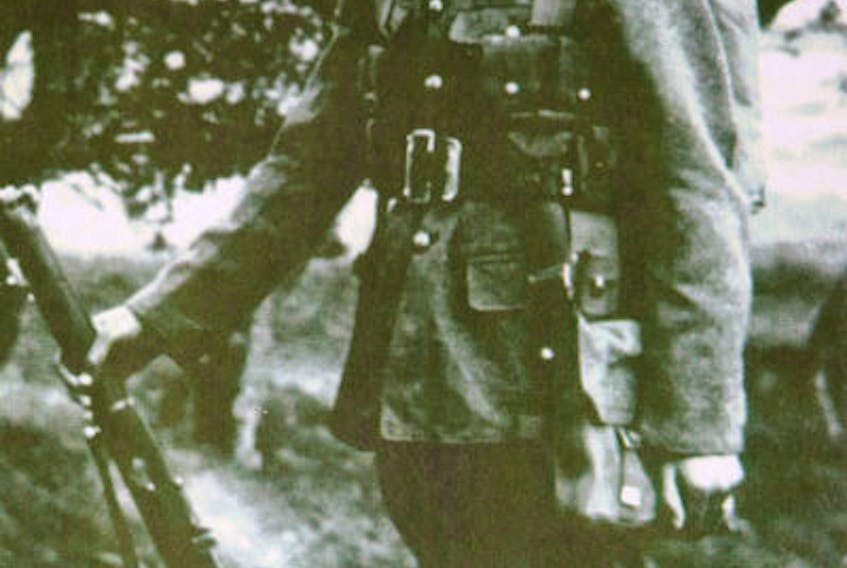In August 1918, when the Saunders family of Carbonear excitedly stood in wait for a wounded — but sufficiently recovered to travel — Pte. Roy Williams Saunders to arrive home from the First World War, eight-year-old Mary became increasingly nervous as the time ticked down to the reunion.
“I don’t know what Roy looks like,” the young girl told her older sister Kathryn as she tugged on her arm. Mary had been only four when her older brother joined the Newfoundland Regiment and went off to war.

Kathryn, who after marriage became Kathryn Saunders Hibbs and went to live in St. John’s, would recall that moment among numerous others in a booklet she wrote in the early 1970s — specifically for descendants of the Saunders family.
But the booklet’s distribution stalled and did not carry on to all the younger generations as Kathryn had hoped.
Jim Saunders of St. John’s, a descendent of one line of the family, found out about the booklet’s existence a year ago through a chance meeting with one of his relatives.
The relative, Philip Saunders, 92, of St. John’s, invited Jim Saunders to his home and there gave him a copy of the booklet.
“I was ecstatic to get that kind of record of my family, particularly the information about Pte. Roy Saunders, whom I knew very little about,” Jim Saunders said last week.
“I was also a little upset that I didn’t know about the booklet all these years. But I’m devoted now to share this with other family members as it was intended.”
And if it wasn’t for him receiving a copy of the booklet, today would have passed without much significance for Jim Saunders.
In it he learned that Pte. Roy Saunders died 100 years ago to this day from the injuries he suffered during the war.
Kathryn’s booklet was titled simply, “Tales Of A Large Family — 1974.” Kathryn was a younger sister of Pte. Roy Saunders. In her opening paragraph she writes, “I have often promised myself that I would jot down a few family anecdotes before they pass into absolute oblivion.
“I’ll probably be dead and gone by the time you hold this in your hands, but as you are a descendant or relative of mine, you will undoubtedly like to know something of your forbearers, so here is a little from the vast memory stores of grandparents, parents, aunts, uncles, etc.”
The few “anecdotes” stretches to 115 pages, and the people and stories therein are not in chronological order, but appears to be in the order of what came to mind as Kathryn sat down to write each day.
For Jim Saunders, digging out the passages about Pte. Roy Saunders’ life and war service was important for this day, and for when family members gather at his gravesite this summer to honour him.
“We are organizing a family reunion from Aug. 2-5, in conjunction with Carbonear Days, and we will do an official gravesite ceremony for Pte. Saunders to formally recognize the 100 years since his death,” he said.
In the booklet, Kathryn describes her family as very musical and Pte. Saunders was no exception. He was also comical and often kept the family entertained.
One time when he was young, she noted, he and another brother Stan got on a train trolley that was left unattended and got it going to the point where they could not slow it down. Some people waved as the trolley passed by not realizing it was out of control. The trolley headed toward the Carbonear station, took a turn at the Y connection, and went off the end of the track near the station and crashed. It “tore great holes in the cinders lying there.” Luckily, neither of the boys were hurt.
Another story notes that Pte. Roy Saunders when young fell off the Salvation Army barracks steps and broke his arm. It wasn’t set properly and his arm always had a bit of a bend in it.
“Another time I remember vaguely about Roy and Stan berry picking in old man Clarke’s garden on the Hoyle’s Road. The old man gave chase and all got away but Roy, who was left with his leg hanging over the fence and in great agony.”
"I’m devoted now to share this with other family members as it was intended.” — Jim Saunders
Kathryn wrote that her brother’s knee was twisted out of joint and was “never 100 per cent” again.
Pte. Roy Saunders was the fourth member of the large family, and was born Dec. 12, 1894. Kathryn wrote that, “he made fun for all of us, was a great musician, artist, and a lovely writer.”
With the start of the First World War, Roy Saunders enlisted in the Newfoundland Regiment and went overseas to fight.
“In 1915 he was wounded at Gallipoli, had shell-shock, nervous breakdown, jaundice and dysentery,” Kathryn wrote. “He was in the Third London General Hospital at Wandsworth until March 1918, when he was sent to France to rejoin the regiment.”
Following one battle, Pte. Roy Saunders was instructed to help the stretcher bearers pick up the wounded and bury the dead, both friend and foe.
Kathryn wrote that it had rained hard one day and he “came across the body of a young German boy of about 15 or 16 lying on his back and staring straight up to the sky. The incessant rain had washed his beautiful blond hair clean and sparkling, his face smooth and unlined, was also spotless. Telling me of this, he said, ‘I looked at that boy and said, My God what a sin’.”
It was at Passchendaele Ridge in Belgium that Pte. Saunders would both prove his great courage and be severely wounded again — injuries that would ultimately linger and lead to his death months later in Newfoundland.

“In this engagement he won the Military Medal for routing a huge nest of German machine gunners although severely wounded himself,” Kathryn wrote.
“He was sent home on Aug. 4, 1918, discharged under medical care. A bullet had torn through his vertebrae, severing three, entering his lung and abdomen. The piece had never been removed from his lung …”
“First when he came from overseas, everyone was running to do him favours.
“When Roy came home first, Billy Clarke … was more than kind to him. How many times did he put a pack of cigarettes in his hand, call him in for a beer on a hot day at Jack McCarthy’s, paying for him to taxi home in bad weather, sending him trout, cod tongues, slipping money in his hand pretty often. Roy always said Billy had a heart as big as a bucket.”
The sweetheart Pte. Roy Saunders had left behind in Carbonear when he went overseas had married by the time he returned. But there were two women in Europe whom he had met, each hoping he’d soon send for them to join him in Newfoundland. He hadn’t totally made his choice, it seems.
The kind and fun-spirited Pte. Saunders tried to resume his life but something wasn’t right in his body.
By April 1919, Pte. Saunders’ lungs began to deteriorate because of the lodged bullet and fragments.
“Mother and Aunt Lizzie nursed him faithfully, and one night we all heard the dreadful sound of Roy, our idol, smothering in his own blood,” Kathryn wrote. “He recovered to wage a manly fight every tedious inch of the way, but when he had a second hemorrhage, he knew he had to be resigned. He died on April 22 at the age of 24, finished before (his life) really began.”
Kathryn noted that his funeral was the largest ever held in Carbonear up to that time.
Jim Saunders is amazed at the detailed information in the booklet, and at Kathryn Saunders Hibbs herself.
“I’m told she was a wonderful person and writer. She did not have any children herself and lived to be almost 100 years of age,” he said. “Because of her book we are going to formally remember Pte. Roy Saunders. We are going to have a reunion. The family that has drifted apart and is again going to be brought together because of her. So, her spirit lives on.”
And maybe that is exactly what Kathryn Saunders Hibbs hoped to achieve.
In her final paragraph she writes, “If you are reading it 50 years from now, consider yourself lucky to have had a look at another age. If you are a descendent of any of the people mentioned herein, you will, no doubt have a special interest and we hope a little pride in what you have read.”
Jim Saunders certainly does.









